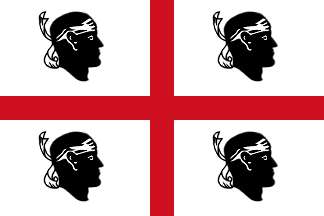
image by Mello Luchtenberg, 28 December 2004

Last modified: 2012-12-31 by rob raeside
Keywords: italy | sardinia | sardegna | moor head | corsica |
Links: FOTW homepage |
search |
disclaimer and copyright |
write us |
mirrors

image by Mello Luchtenberg, 28 December 2004
See:
See also:
Other sites:
The traditional flag of Sardegna (dated from the end of the
14th century) is the white one with the red cross and the four
moors heads. As such it was used by ships sailing from island
harbours when Sardinia was part of the Kingdom of Sardinia. When
in 1802 (and until 1814) the Kingdom was reduced to the island
itself, the Savoias replaced the Savoia cross in the canton of
the naval ensign of the kingdom with the Sardinia ensign.
Mario Fabretto ,17 September 1997
The gonfalon and the coat of arms were adopted on the 5th July
1952. The coat of arms is argent a cross gules and a Moor’s
head sable in each canton. The gonfalon is white with the coat of
arms in the middle and the words Regione autonoma Sardegna
in gold on a green ribbon. The traditional flag of Sardinia is a
banner of the arms. A proposal of law to officialize this flag
was made on the 18th July 1997.
Pascal Vagnat, 22 September 1998
The flag of Sardinia is the traditional arms of sardinia,
based on the Genoese red cross. Note that nearby Corsica also has a moor's head in its arms.
Francois Velde, 12 April 1996
Sardinia adopted on the 15th April 1999 the traditional flag
of the island, that is white with a red cross and a black moor's
head, with a white headband, above the eyes. An official model
shall be adopted soon by the president of the region.
Sources: <consiglio.regione.sardegna.it/legapp/lr99-10.htm>
(law). (see also: <propleg349.htm>
(proposal and explanations) and <propleg517a.htm>
(correction proposed for the law, considering the present
situation with the flags available on the island).
Pascal Vagnat , 6 July 1999
I've taken that image
from the 1771 Encyclopedia Britannica. On a white field a red St.
George's cross between four black Moors' heads. There are no
blindfolds shown on these, however. Does anyone know when the
switch to the blindfold occurred?
Randy Young ,1 December 1998
It is headbands, not blindfolds, which appear on the Moors'
heads on the traditional flag of Sardinia.
Ned Smith ,1 December 1998
The cover of Klaes Sierksma's: "Vlaggen: Symbool ·
traditie · protocol" [sie63]
shows what the book describes as approximately a quarter of a
flagchart, one of many to roll of the, mostly Dutch, presses for
the use of seafarers: "Tableau des Pavillons que la Plupart
des Nations arborent á la Mer. Faitau dépôt des cartes et
plans de la marine pour le service des vaisseaux du Roy par ordre
de M. de Machault, Garde de séaux de France. Par le Sr. Bellin
Inge'nieur de la marine. 1756." [beL56].
On the 3rd row from the bottom there is "Pav. de
Sardaigne" - A white flag with a red cross; the width of the
arms 1/10th of the hoist. In each quarter a black moor's head,
from the neck up, looking slightly upward. Around each head a
white scarf is tied, with the knots, of which (nearly) no ends
protrude, behind the heads.
Peter Hans van den Muijzenberg, 4 January 2001
According to Mario Daliceri and Roberto Breschi, and as is
pictured in the last regional law about symbols, the moors head
are currently faced to the fly and have a bit different look.
Jaume Ollé, 29 April 2001
Strange because if you take the Coat of Arms, you would say
the moor head should face the hoist. Also on every picture you
see on the Internet. There is a description
in Italian:
"Art. 1 - Bandiera della Sardegna - La Regione adotta quale
sua bandiera quella tradizionale della Sardegna: campo bianco
crociato di rosso con in ciascun quarto una testa di moro bendata
sulla fronte rivolta in direzione opposta all'inferitura."
Mello Luchtenberg, 29 April 2001
Translation:
Art.1 - Flag of Sardinia - The Region adopts as its flag the
traditional flag of Sardinia: a white field with red cross, a
Moor head with a bend in each canton looking at the fly.
Pier Paolo Lugli, 30 April 2001
At J.W Norie - J.S. Hobbs Flaggen aller seefahrenden Nationen,
1971 [nor71] (original print
1848):
192 Island of Sardinia - A St. George's cross with each quarter a
moor head, except the bands are placed as blind-folds.
Peter Hans van den Muijzenberg, 12 November 2001
The official website of Regione Sardegna has an interesting
page on the Sardinian flag (<www.regione.sardegna.it>).
The flag is nicknamed "the Four Moors' Banner"
("Bandiera dei Quattro Mori". The flag is white with a
red cross and four Moor's heads in the quarters.
According to the Iberic tradition, the flag was created by King
of Aragon Peter I after the victory of Alcoraz (1096). The battle
was won with the help of St. George, therefore the red cross, who
abandoned on the battle field the heads of the four defeated
Moorish kings. The Sardinian tradition associated the Four Moors'
banner to the mythical standard given by Pope Benedict II to the
Pisans, who helped the Sardinians to fight the Sarracen invaders
in 1017.
In fact, the oldest representation of the emblem dates back to
1281, and can be seen on a seal of the Royal Chancellery of Peter
the Great of Aragon. The Four Moors were associated to Sardinia
only in the second half of the XIVth century, when the Kingdom of
Sardinia was part of the Confederation of the Crown of Aragon, as
shown on the Gerle Armorial. The emblem was widely used in the
Spanish Sardinia, on engravings, coins and the standards of the
special corps "Tercios de Cederna", created by Don
Carlos to protect the island, and which fight the Turks in Tunis
(1535) and Lepante (1571).
The representation of the Moors was not fixed: the Moors might
face right or left or each other two by two, might be crowned,
and might be banded.
In the middle of the XVIIIth century, the representation was
fixed: the Moors faced left and were eye-banded. A given reason
for this is the lack of liberalism of the Piemontese government
against the Sardinian population. The emblem was shown on the
amrs of the Piemontese dynasty, on the official documents and
coins of the Kingdom of Sardinia, and on militia flags. The
emblem was later used by the "Brigata Sassari" who
fought the Austrians during the Second World War [I would rather
say First World War].
In 1952, by a Decree of the President of the Region dated 5 July
1952, the emblem was placed on the gonfalone of the Autonomous
Region of Sardinia and became the official symbol of the Region.
The flag of the Region was prescribed by Regional Law of 15 April
1999. The Four Moors face the fly and the band was placed on
their forehead.
Source: B. Fois "Lo stemma dei quattro mori, breve storia
dell'emblema dei Sardi". Carlo Delfino Editore, Sassari
(1990).
Ivan Sache, 19 April 2002
The Moors' heads appeared originally in Aragonese and Catalan
coats- and banners-of-arms in several places throughout their
Mediterranean domains (Aragon, Corsica, Sardinia etc.). They intended to
represent Moorish kings defeated and/or captured in combat (no
actual persons and in no real number) and hence the Catalan and
Aragonese participation in the Reconquest. In Medieval heraldry
they were simply blazoned as "moors' heads" (or more
frequently "blackamoors' heads" in English heraldry)
and it was irrelevant where was the "tortil" (a
headband , not a blindfold) placed or even whether it appeared at
all.
Santiago Dotor , 9 March 2000
At the webpage <www.pbs.org>,
located by Ned Smith there is an article is entitled:
SIGILLUM SECRETUM (Secret Seal) - On the image of the Blackamoor
in European Heraldry (a preliminary proposal for an
iconographical study) by Mario de Valdes y Cocom.
The parts relevant to the Moor's head in flags says:
1. The four Moor's head shown on the flag of Sardinia are
traditionally assocaited to the four Moorish emirs which were
defeated by a king of Aragon (XIth century). As a corollary, the
Black figure became a symbol of evil.
2. Modern heraldits suspect that the Moor's head is, however, the
very opposite of a negative symbol. The Moor's head could have
referred to St. Maurice, the black patron saint of the Holy Roman
Empire from the beginning of the 10th century. Maurice has been
portrayed as black since the XIIth century. Here I prefer to
quote the original text to avoid misinterpretation:
'The insignia of the black head, in a great many instances, was
probably meant to represent this soldier saint since a majority
of the arms awarded were knightly or military. With 6,666 of his
African compatriots, St. Maurice had chosen martyrdom rather than
deny his allegiance to his Lord and Saviour, thereby creating for
the Christian world an image of the Church Militant that was as
impressive numerically as it was colourwise. Here, no doubt, is a
major reason why St. Maurice would become the champion of the old
Roman church and an opposition symbol to the growing influence of
Luther and Calvin. The fact that he was of the same race as the
Ethiopian baptized by St. Philip in Acts of the Apostles was
undoubtedly an important element to his significance as well.
Since this figure from the New Testament was read as a
personification of the Gentile world in its entirety, the
complexion of St. Maurice and his Theban Legion (the number of
which signified an infinite contingent) was also understood as a
representation of the Church's universality - a dogmatic ideal no
longer tolerated by the Reformation's nationalism. Furthermore,
it cannot be coincidental that the most powerful of the German
princes to remain within the Catholic fold, the archbishop
Albrecht von Brandenburg, not only dedicated practically all the
major institutions under his jurisdiction to St. Maurice but in
what is today one of the most important paintings of the
Renaissance, had himself portrayed in Sacred Conversation with
him. Even more blatant was the action taken by Emanual Philibert,
Duke of Savoy. In 1572 he organized the order of St. Maurice. The
papal promulgation published at its institution declared quite
unequivocally that the sole purpose for this knighthood was to
combat of the Reformation. The order still exists although it has
now combined with the Order of St. Lazarus. The white trefoiled
cross of the combined order belongs to the former. The particular
symbol of St. Maurice's blackness that must have most antagonized
the Protestant faction, however, was the one regarding the
mystery of Papal authority. Scholars have been able to show, for
example, that in the theological debates of this period, even the
abstract adjectives, black and white, were defiantly acknowledged
by apologists of both stripes to represent
the Church and the Reformers respectively."
Ivan Sache, 18 February 2001
Translated from <www.regione.sardegna.it>:
"Now Sardinain people have their flag (Regional Law number
10 of April15th, 1999), but, due to the old Piedmontese affront,
the four moors have meaningfully turned their heads and opened
their eyes, no more covered by the bands which now have returned
to be placed on their foreheads." Version in Sardinian at
<www.regione.sardegna.it/4mori_sardo.htm>.
Paolo Montanelli, 25 July 2003
See also: Corsica
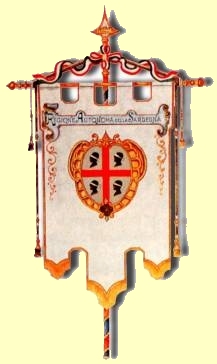
image from <213.82.237.77/culture/v1.asp>,
located by Dov Gutterman, 13 August 2002
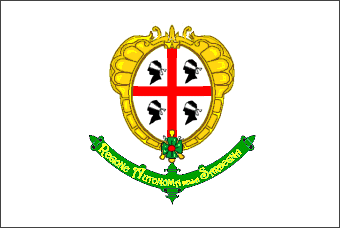
image by Roberto Breschi from CISV
The regional flag is the one with the coat of arms . We could
consider this as the flag used by government institutions, while
the above is "de facto" for civil use. Indeed the
regional flag is also used by private citizens, so the
traditional flag must be considered as a historic flag.
Mario Fabretto, 17 September 1997
The previous flag that was white with complex arms in center.
The image is according to information and images posted by Mario
Dalcieri and Roberto Breschi, CISV members).
Jaume Ollé, 29 April 2001
Note that the "previous flag" seems to be a kind of
official emblem of the Region, since it is shown on the top of
every page of the official website of the Region.
Ivan Sache, 19 April 2002
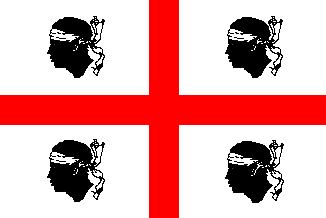
image by Ivan Sache , 3 January 2000
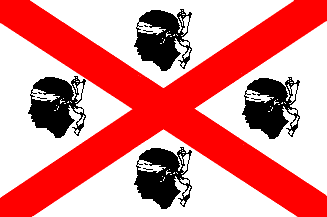
image by Jaume Ollé ,13 October 1998
Sardinia island flag according old plates.
Jaume Ollé ,13 October 1998